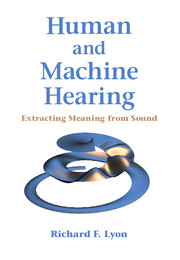Part IV - The Auditory Nervous System
Published online by Cambridge University Press: 28 April 2017
Summary
Part IV Dedication: J. C. R. Licklider
This part is dedicated to the memory of Joseph Carl Robnett Licklider (1915–1990). “Lick” is best known as one of the “fathers of the Internet” (Poole et al., 2005), based on his ARPA leadership and his writings such as “Man–Computer Symbiosis” and “The Computer as a Communication Device.”
But before he was a computer network and systems guy, Lick was an auditory psychologist and modeler (November, 2012). His work on pitch perception, as represented in the “duplex theory,” is the basis for much recent work in hearing, including my own, connecting the output of the cochlea to perception and neural processing of complex sounds.
I had the pleasure of meeting Lick just once, in 1984 at a Navy-sponsored workshop on “Artificial Intelligence and Bionics.” I think he was a little surprised to see his duplex theory coming back as a practical computational approach, three decades after he came up with it. It has become even more practical since then, thanks partly to his computer innovations.
In this part, we discuss the levels of processing in the auditory nervous system. We develop the idea of auditory images, of the sort that are thought to be extracted by brainstem and midbrain for projection to auditory cortex.
We start where the last part left off, with the “cable” for the telephone theory of hearing, the auditory nerve, which transmits the vibrations as detected by hair cells in the cochlea to the first stop in the brainstem, the cochlear nucleus.
Several kinds of processing in the cochlear nucleus support both binaural hearing and the extraction of properties such as pitch and timbre that can be monoaural or binaural. We cover the extraction of such properties into the stabilized auditory image, a basis for sound representation in machine hearing systems as well as a model of representations in the inferior colliculus of the midbrain. We cover binaural spatial processing and the brainstem's olivary complex. We finish this part with a discussion of auditory scene analysis as the main aim of the auditory brain, and some ideas for how such analysis might be done in the thalamus and cortex to finally “extract meaning.”
- Type
- Chapter
- Information
- Human and Machine HearingExtracting Meaning from Sound, pp. 345 - 346Publisher: Cambridge University PressPrint publication year: 2017



